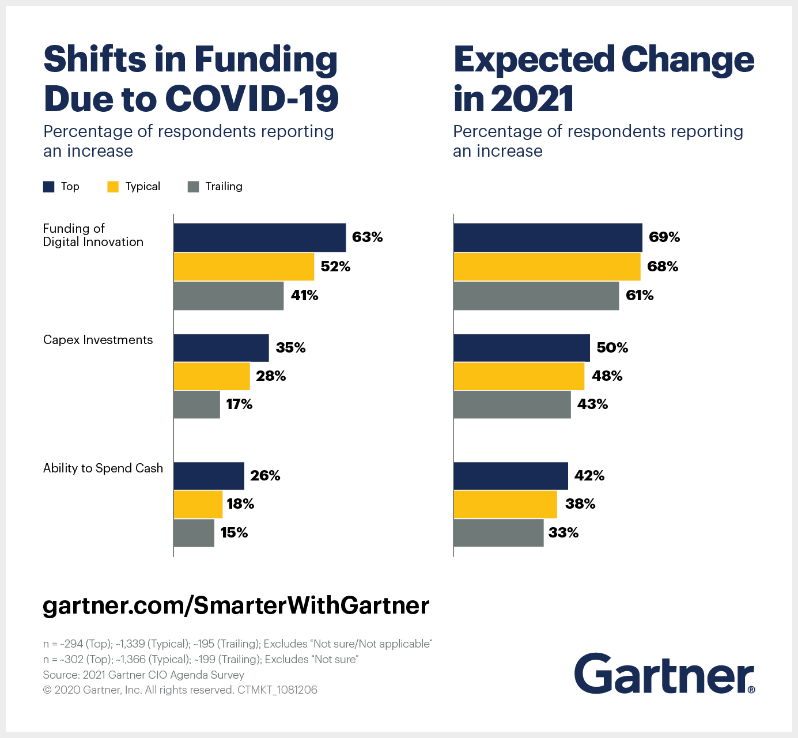Finally, the most important lesson of this past year has been a confirmation of what many experts already knew — digital transformation is about more than just IT. While technology is a key component in helping your business identify and respond to evolving organizational and customer needs, even the most advanced solutions are only as effective as the user. To maximize the value of transformation, leaders must support the human side of change by establishing a change-ready culture and driving long-term adoption and sustainment.
With these principles at the heart of your strategy, you can begin taking steps toward digital innovation in 2021 and beyond.
5 steps to digital transformation
Whether your business is focused on leveraging distributed cloud, Artificial Intelligence (AI) or the newly dubbed Internet of Behaviors (IoB) to accelerate growth in the coming years, successful digital transformation begins with a conscious balance between the human and technical sides of change.
Use these five steps to guide your transformation journey.
Step 1: Identify your challenge.
Before investing in a digital transformation initiative, you’ll need to first identify, analyze and clearly define the core business need that a new technology or process will address. While it can be tempting to jump ahead to evaluating solutions, it’s important to resist this urge. Take the time to really understand the drivers in order to avoid misalignment and wasted investments down the line.
A few helpful strategies include:
- Start at the source — the catalyst for change is often a good indicator of where underlying challenges may exist.
- Use interviews or surveys to get a better understanding of workforce or customer needs.
- Leverage existing data to help pinpoint inefficiencies or verify anecdotal challenges.
Step 2: Prepare for change.
Successful transformation depends on people adopting new ways of thinking and working. The more a project depends on people changing mindsets or behaviors, the higher the uncertainty of Return on Investment (ROI). Organizational Change Management (OCM) provides the quantitative, data-driven processes to evaluate and manage the human side of change. Leveraging OCM to assess your organization’s readiness for change early on can help you get a better sense of the scope and scale of potential challenges on your transformation journey.
A few valuable tools include:
- The Prosci Project Change Triangle
- A sponsorship and leadership assessment
- The ADKAR scoring tool
Step 3: Enable your workplace.
Regardless of your goals for digital transformation, you’ll need to ensure the technology, data and people that make up your organization work together effectively to meet your business requirements — now and in the future. An Enterprise Architecture (EA) strategy will help to guide the decision-making process, providing essential visibility, consistency and scalability. Once you’ve established your EA strategy, you can then begin to build out the key technology enablers, tools and skills that will be required to support your implementation.
As you plan, it will be important to establish best practices around:
- Cloud, multicloud and hybrid cloud
- Edge computing
- Software as a Service (SaaS)
- Microservices and Application Programming Interfaces (APIs)
Step 4: Execute iterative and incremental transformation.
Embracing digital transformation requires organizations to manage combined and often conflicting challenges of rapid change amidst vague constraints and complex interdependencies. Attempting to tackle these issues with a traditional waterfall methodology is cumbersome and incurs a great deal of risk. Instead, the iterative and incremental approaches supported by Agile and DevOps are far more effective. These models go hand in hand to support the steady, ongoing delivery of results through a cyclical pattern of releases and upgrades.
The benefits of implementing both Agile and DevOps for transformation include:
- The integration or removal of silos in support of common goals
- Improved focus on next-best investments for sustainable value flow
- Faster, more frequent deployment to production
- Greater productivity, less stress
Step 5: Manage ongoing change.
It’s important to remember that everyone adapts to change at their own pace. As new technologies and processes are implemented, you’ll need to continue to leverage the principles and practices of OCM to manage the effects of change and ensure long-term adoption and usage. Demonstrating active and engaged leadership will be key to the success of your initiative. Likewise, proactive and consistent two-way communication will reinforce the value of change while helping to identify any areas of resistance.
The five levers of OCM give you the tools to maximize the value of change:
- Sponsorship and support from leadership
- An effective communications strategy
- A coaching plan for management and supervisors
- Training for employees and end users
- Proactive resistance management
Success starts here.
As you begin transforming your business for 2021 and beyond, remember, no significant change is easy — but any easy project probably won’t end up having the desired effect. And the cost of stagnation is much larger than the day-to-day impact of transformation.
Setting clear expectations and managing through iteration and adoption is key. And, wherever possible, don’t hesitate to leverage strategic partnerships or managed services to guide and support your goals. Traditionally, it takes 10+ IT partners to successfully execute a transformation. This support not only improves project outcomes, but also empowers your workforce to stay focused on your business.
In the end, the value of digital transformation doesn’t come from orchestrating 1,000 great ideas. It comes from persevering with a few great ideas that can be continuously adapted, improved and built upon over time.






